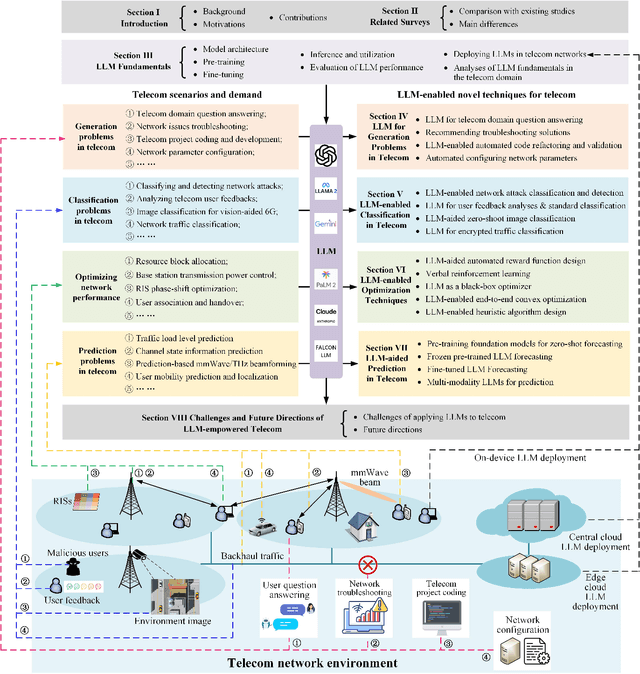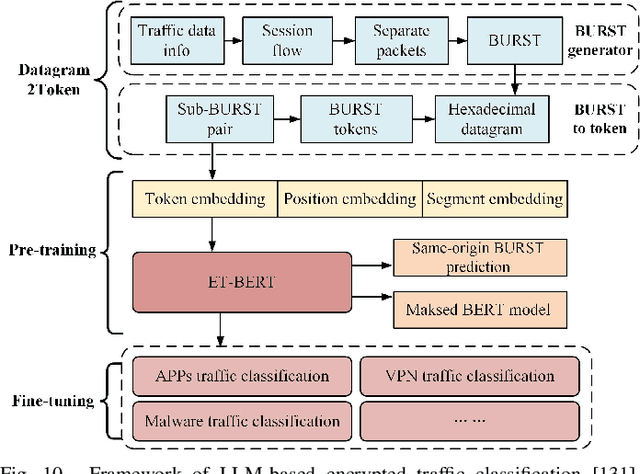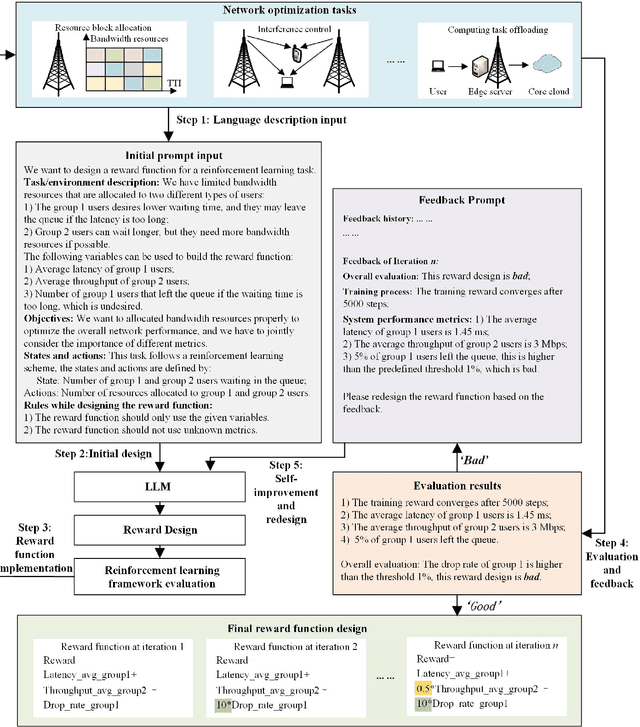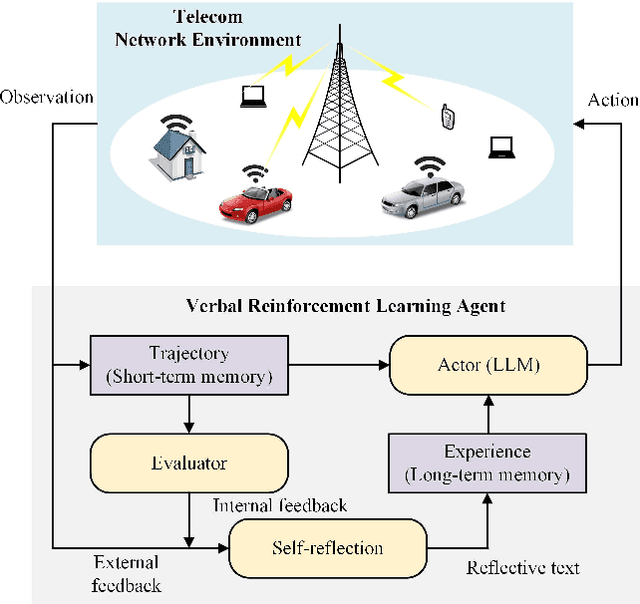Dun Yuan
Charlie
Prompting Wireless Networks: Reinforced In-Context Learning for Power Control
Jun 06, 2025Abstract:To manage and optimize constantly evolving wireless networks, existing machine learning (ML)- based studies operate as black-box models, leading to increased computational costs during training and a lack of transparency in decision-making, which limits their practical applicability in wireless networks. Motivated by recent advancements in large language model (LLM)-enabled wireless networks, this paper proposes ProWin, a novel framework that leverages reinforced in-context learning to design task-specific demonstration Prompts for Wireless Network optimization, relying on the inference capabilities of LLMs without the need for dedicated model training or finetuning. The task-specific prompts are designed to incorporate natural language descriptions of the task description and formulation, enhancing interpretability and eliminating the need for specialized expertise in network optimization. We further propose a reinforced in-context learning scheme that incorporates a set of advisable examples into task-specific prompts, wherein informative examples capturing historical environment states and decisions are adaptively selected to guide current decision-making. Evaluations on a case study of base station power control showcases that the proposed ProWin outperforms reinforcement learning (RL)-based methods, highlighting the potential for next-generation future wireless network optimization.
Enhancing Large Language Models (LLMs) for Telecommunications using Knowledge Graphs and Retrieval-Augmented Generation
Mar 31, 2025Abstract:Large language models (LLMs) have made significant progress in general-purpose natural language processing tasks. However, LLMs are still facing challenges when applied to domain-specific areas like telecommunications, which demands specialized expertise and adaptability to evolving standards. This paper presents a novel framework that combines knowledge graph (KG) and retrieval-augmented generation (RAG) techniques to enhance LLM performance in the telecom domain. The framework leverages a KG to capture structured, domain-specific information about network protocols, standards, and other telecom-related entities, comprehensively representing their relationships. By integrating KG with RAG, LLMs can dynamically access and utilize the most relevant and up-to-date knowledge during response generation. This hybrid approach bridges the gap between structured knowledge representation and the generative capabilities of LLMs, significantly enhancing accuracy, adaptability, and domain-specific comprehension. Our results demonstrate the effectiveness of the KG-RAG framework in addressing complex technical queries with precision. The proposed KG-RAG model attained an accuracy of 88% for question answering tasks on a frequently used telecom-specific dataset, compared to 82% for the RAG-only and 48% for the LLM-only approaches.
Large Language Model (LLM) for Telecommunications: A Comprehensive Survey on Principles, Key Techniques, and Opportunities
May 17, 2024



Abstract:Large language models (LLMs) have received considerable attention recently due to their outstanding comprehension and reasoning capabilities, leading to great progress in many fields. The advancement of LLM techniques also offers promising opportunities to automate many tasks in the telecommunication (telecom) field. After pre-training and fine-tuning, LLMs can perform diverse downstream tasks based on human instructions, paving the way to artificial general intelligence (AGI)-enabled 6G. Given the great potential of LLM technologies, this work aims to provide a comprehensive overview of LLM-enabled telecom networks. In particular, we first present LLM fundamentals, including model architecture, pre-training, fine-tuning, inference and utilization, model evaluation, and telecom deployment. Then, we introduce LLM-enabled key techniques and telecom applications in terms of generation, classification, optimization, and prediction problems. Specifically, the LLM-enabled generation applications include telecom domain knowledge, code, and network configuration generation. After that, the LLM-based classification applications involve network security, text, image, and traffic classification problems. Moreover, multiple LLM-enabled optimization techniques are introduced, such as automated reward function design for reinforcement learning and verbal reinforcement learning. Furthermore, for LLM-aided prediction problems, we discussed time-series prediction models and multi-modality prediction problems for telecom. Finally, we highlight the challenges and identify the future directions of LLM-enabled telecom networks.
Realizing XR Applications Using 5G-Based 3D Holographic Communication and Mobile Edge Computing
Oct 05, 2023Abstract:3D holographic communication has the potential to revolutionize the way people interact with each other in virtual spaces, offering immersive and realistic experiences. However, demands for high data rates, extremely low latency, and high computations to enable this technology pose a significant challenge. To address this challenge, we propose a novel job scheduling algorithm that leverages Mobile Edge Computing (MEC) servers in order to minimize the total latency in 3D holographic communication. One of the motivations for this work is to prevent the uncanny valley effect, which can occur when the latency hinders the seamless and real-time rendering of holographic content, leading to a less convincing and less engaging user experience. Our proposed algorithm dynamically allocates computation tasks to MEC servers, considering the network conditions, computational capabilities of the servers, and the requirements of the 3D holographic communication application. We conduct extensive experiments to evaluate the performance of our algorithm in terms of latency reduction, and the results demonstrate that our approach significantly outperforms other baseline methods. Furthermore, we present a practical scenario involving Augmented Reality (AR), which not only illustrates the applicability of our algorithm but also highlights the importance of minimizing latency in achieving high-quality holographic views. By efficiently distributing the computation workload among MEC servers and reducing the overall latency, our proposed algorithm enhances the user experience in 3D holographic communications and paves the way for the widespread adoption of this technology in various applications, such as telemedicine, remote collaboration, and entertainment.
Mixed-Variable PSO with Fairness on Multi-Objective Field Data Replication in Wireless Networks
Mar 23, 2023



Abstract:Digital twins have shown a great potential in supporting the development of wireless networks. They are virtual representations of 5G/6G systems enabling the design of machine learning and optimization-based techniques. Field data replication is one of the critical aspects of building a simulation-based twin, where the objective is to calibrate the simulation to match field performance measurements. Since wireless networks involve a variety of key performance indicators (KPIs), the replication process becomes a multi-objective optimization problem in which the purpose is to minimize the error between the simulated and field data KPIs. Unlike previous works, we focus on designing a data-driven search method to calibrate the simulator and achieve accurate and reliable reproduction of field performance. This work proposes a search-based algorithm based on mixedvariable particle swarm optimization (PSO) to find the optimal simulation parameters. Furthermore, we extend this solution to account for potential conflicts between the KPIs using {\alpha}-fairness concept to adjust the importance attributed to each KPI during the search. Experiments on field data showcase the effectiveness of our approach to (i) improve the accuracy of the replication, (ii) enhance the fairness between the different KPIs, and (iii) guarantee faster convergence compared to other methods.
 Add to Chrome
Add to Chrome Add to Firefox
Add to Firefox Add to Edge
Add to Edge